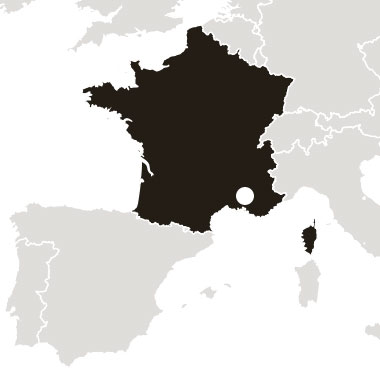De smaak
Prémices is een ‘masterpiece’ van Francois en Marie Giraud.
Rondom verrukkelijk met karakteristieke aroma’s van vanille, bloemen, toast, tabak en donker fruit. Ongelooflijk puur en zijdezacht en nu al elegant in de smaak.
Eerste jaargangen 2010 en 2011 direct met hoge waarderingen van zowel experts als liefhebbers (score Vivino:4.3/5.0 "High").
De details
Type wijn: full bodied, rode wijn
Druivensoort: grenache
Teelt: conventioneel
Opvoeding: 2/3 stalen tank, 1/3 Frans eiken
Alcoholgehalte: 15% vol.
Afsluiting: natuur kurk
Drinktemperatuur: 17 graden
Bewaarpotentieel: 2013 - 2023
Spijs-aanbeveling:
- Vlees: rood vlees, wildgerechten(rood) en gevogelte(rood)
- Kaas: stevig, oud en gerijpt
De oorsprong
Zelfs een prestigieus en eeuwenoud domein als Giraud had verjonging nodig om haar buitengewone trackrecord van top Cuvées in de toekomst te behouden. Dit is zeker het geval door het aantreden van de ‘up-and-coming' supersterren in Chateauneuf-du-Pape, Francois en Marie Giraud. In 2007 trokken ze al de aandacht van Robert Parker om vervolgens deze grootse Chateauneuf du Pape’s te produceren. Zo ook, deze nieuwe Châteauneuf du Pape Prémices, een ‘masterpiece’!
Door hun talent is het duo van nature omringd met de top van Frankrijks wijnmakers. Philippe Cambie al jaren nauw betrokken als de oenoloog, is in 2010 uitgeroepen tot oenoloog van het jaar in The Wine Advocate. Het is dit team dat het eeuwenoude domein Giraud laat schitteren en in staat is kwaliteitstandaard op het allerhoogste niveau te leggen. Een domein dat we op de voet volgen.
Volgens SlimmerWijnKopen.nl
Een gemeen goede Châteauneuf-du-Pape. Francois en Marie Giraud waren meteen enthousiast over SlimmerWijnKopen.nl en voelden zich zelfs vereerd om tot de openingsdeals te behoren.
Slimme Weetjes: De zuidelijke Rhône regio
The southern Rhône sub-region has a more Mediterranean climate with milder winters and hot summers. Drought can be a problem in the area, but limited irrigation is permitted. The differing terroirs, together with the rugged landscape which partly protects the valleys from the Mistral, produce microclimates which give rise to a wide diversity of wines. A feature of the cultivation of the region is the use of large pebbles around the bases of the vines to absorb the heat of the sun during the day to keep the vines warm at night when, due to the cloudless skies, there is often a significant drop in temperature.
The southern Rhône's most famous red wine is Châteauneuf-du-Pape, a blend containing up to 19 varieties of wine grapes (ten red and nine white) as permitted by the Châteauneuf-du-Pape AOC rules. Other nearby AOC regions including Coteaux du Tricastin AOC, Côtes du Ventoux AOC, Côtes du Vivarais AOC, Lirac AOC, Tavel AOC and Vacqueyras AOC may contain even more varieties in the blend.
Gigondas AOC, on the other hand, is predominantly made from Grenache noir has a more restricted set of permitted grapes. Depending on the specific AOC rules, grapes blended into southern Rhône reds may include Grenache, Syrah, Mourvèdre, Carignan and Cinsault. The reds from the left bank are full bodied, rich in tannins while young, and are characterized by their aromas of prune, undergrowth, chocolate and ripe black fruit. The right bank reds are slightly lighter and fruitier. From Wikipedia, the free encyclopedia.
Slimme Weetjes: Rondom Châteauneuf-du-Pape
The village and three other surrounding communes produce wine, and Châteauneuf-du-Pape is an Appellation d'Origine Contrôlée (AOC) in the southern Rhône wine region. Unlike its northern Rhône neighbors, Châteauneuf-du-Pape permits thirteen different varieties of grape; the blend is usually predominantly Grenache. Other red grapes include Cinsault, Counoise, Mourvèdre, Muscardin, Syrah, Terret noir, and Vaccarèse. White grapes include Grenache blanc, Bourboulenc, Clairette, Picardan, Roussanne, and Picpoul.
In recent years, the trend has been to include fewer (or even none) of the allowed white varieties and rely heavily (or solely) upon the Grenache, Mourvèdre, and Syrah. One may suspect that this is a response to international wine-market trends and the desire to have this sometimes-rustic wine appeal to a broader commercial audience.
Before wine critic Robert M. Parker, Jr. began promoting them, the wines of Châteauneuf were considered rustic and of limited appeal. However, his influence increased their price more than fourfold in a decade. In gratitude, the Châteauneuf Winemakers Union pushed for his becoming an honorary citizen of the village. From Wikipedia, the free encyclopedia.


